
Background information
VFX: Cinema from the computer
by Luca Fontana

Computer-generated effects in films are evil and come from the depths of hell. That’s the common view, as the effects are looking more and more artificial, even though they’re actually getting better. Why is that? Let’s try to explain.
Last week I published an article on fleeing Lord of the Rings warriors. The article focused on software developed especially for the films to animate vast armies. The only stupid thing was that thousands of soldiers weren’t up for a proper battle and just ran away in the first tests.
Of course, the developers sussed out what went wrong and the Lord of the Rings series is now known for its eye-opening mass battles.
But then I read this user comment:
Personally, I found the CGI mass battles in the Hobbit series a bit…well, tedious. They just didn’t look real. They remind me of the Agent Smith scene in «The Matrix Reloaded». Maybe someone could write a nice little anecdote about that :-)
This reader is certainly not alone. Most people seem to think that modern 3D computer-generated effects (computer-generated imagery, or CGI) are bad and come from the depths of hell. That’s why I came up with the idea of a sequel to my first «Computer-made cinema» article.
But why don’t we like CGI? I mean, you only need to spend a few minutes on Google to find a host of articles, forum posts and YouTube videos on why the 1993 T-Rex looks more realistic than the one in «Jurassic World» – a film made a whopping 25 years later.
There’s obviously something wrong here. And I want to know what it is.
Let’s go back to November 2014, when the first trailer for the eagerly awaited «Jurassic Park» found its way online.
Just two and a half minutes, which press all of the right buttons to whip millions of fans into a frenzy about the next dinosaur-packed adventure. But the trailer – and the entire film, in fact – also symbolise why computer-generated effects are so frowned upon: they’re everywhere.
For example, look more closely at the sequence from 1:00. It shows a SeaWorld-worthy water show, but with dinosaurs in the title roles.
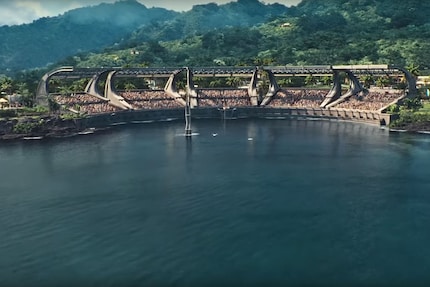

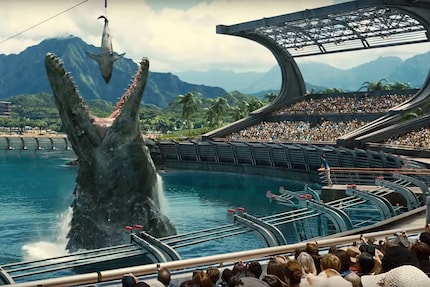
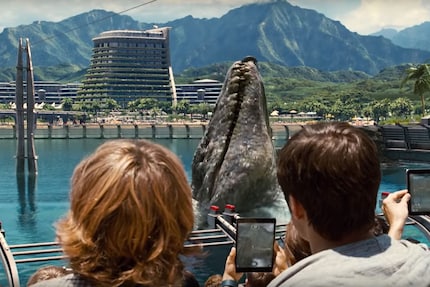
Image source: Universal Pictures
The scene’s aim is to amaze us and elicit «oohs» and «ahhs» – just like the onlookers in the film – but it fails on every count. Why? Not necessarily because the effects aren’t good. On the contrary: keeping things in perspective, they’re actually impressive and considerably better than 25 years ago. That said, nothing in the scene is real apart from a few people in the foreground, and this is where the problem lies.
We’re watching an artificial dinosaur eat an artificial shark and dive back into artificial water in an artificial arena watched by an artificial crowd – and two real boys applaud the events.
The artificiality of this scene creates nothing but emotional distance. A few actors are sitting in front of a green screen and cheering as if they’re seeing something amazing, which isn’t actually there. The event is so replaceable that it was actually replaced before the film’s release.
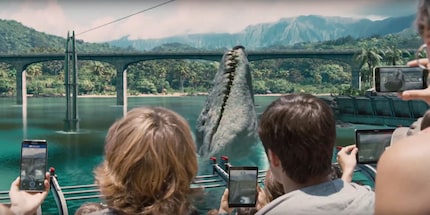
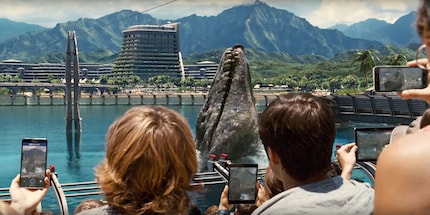
Image source: Universal Pictures
Don’t get me wrong. Sometimes there’s no other way to tell a story. But when it’s not just the odd scene, but the whole film that looks like it’s straight out of a video game, the makers can hardly be surprised when their audience doesn’t have any emotional connection to their creation and start to question the use of CGI.
But why are there so many computer effects these days? Ironically, the answer has a lot in common with the plot of «Jurassic World». In the film, the park visitors get used to the existence of dinosaurs and are no longer easily impressed. The park operators decide that they have to create new, more exciting dinosaurs to win back their visitors’ interest – and they overdo it.
That’s exactly how it is with CGI. Long gone are the times when a Brachiosaurus plucking leaves from a tree was enough to amaze us. It takes more: more action, more explosions, more computer-generated effects. And the filmmakers are taking things too far.
In «Jurassic World», the characters think they can create better dinosaurs thanks to developments in genetic engineering. The real-world equivalent is much more powerful computers, which are used to create better special effects even faster than before.
Remember this Jeep chase scene from «Jurassic Park»?
«You must go faster», the chase starts at 0:41
The filmmakers took 12 hours per frame to create this scene. One second on screen is made up of 24 frames. This means that the three seconds that the T-Rex can actually be seen took 864 hours of work. That totals 36 days, so more than a month. An eternity.
So some things have really changed: computer-generated effects used to be much more laborious and took much, much longer. Filmmakers used to think twice about whether they wanted the hassle of creating CGI. CGI effects were the last resort and were saved for huge cinematic moments where real manual effects just wouldn’t cut it.
These days, of course, things could hardly be more different. It’s now apparently good form to mess around with CGI and animate things that would have been just as good done for real.
It strikes me that computer-generated effects are increasingly used to replace reality entirely rather than enhancing or expanding on it. Let’s take the Matrix trilogy as an example. In «The Matrix», you see the actual actors fighting or flying through the air. CGI is only used as an enhancement, such as bullet time, where bullets spray through the air like water.
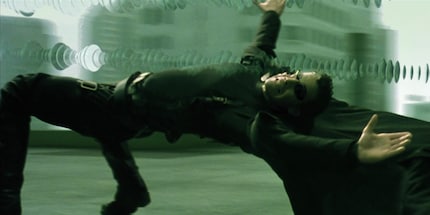
The actors in the sequel, «The Matrix Reloaded», are completely replaced rather than enhanced. The fight scene where Neo takes on a hundred Agent Smiths has become one of the most popular examples of bad CGI.
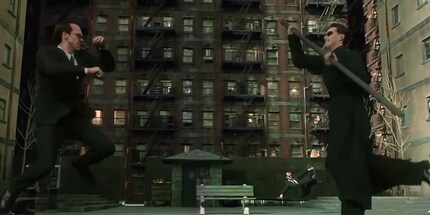
The scene is primarily criticised because the computer-animated actors feel too light on the screen, like puppets being flung around by a hot-tempered child on a sugar high.
But the problem doesn’t end there. Our understanding of physics tells us that something’s not right about the weight of the figures, but our brains don’t actually know how hundreds of people flying through the air should look. We might enjoy the visual spectacle, but no-one finds it exciting because there’s no relation to real life: we cut ourselves off emotionally.
I don’t think I have any idea how a half-tonne robot should look when thrown out of a bus, but this isn’t it (from 0:23):
Arnie flies out of the bus from 0:23, looking more like a doll than a killer robot
It looks so hilariously unrealistic that it falls flat on its face. The same goes for the depiction of Legolas’ gravity in virtually every film he appears in.
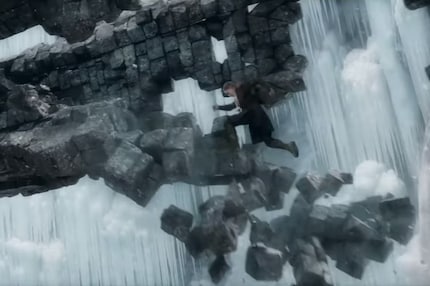
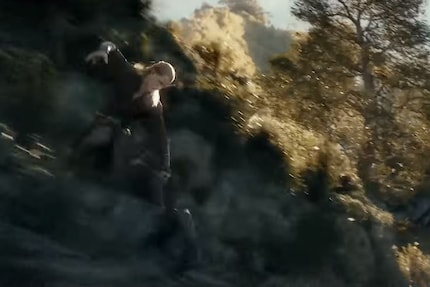
«The Hobbit», New Line Cinema
I don’t want to go on about it. Films tell stories that are bigger than our small world. Fantasy films transport us to unfamiliar worlds, where superheroes take on intergalactic threats, and sci-fi flicks take us to the future or roam through space – not everything can be reduced to manual effects or scenarios already familiar to us.
But filmmakers must remember that every fantastic element risks the audience losing their emotional connection with the events. If characters are no longer exposed to danger that viewers can identify with and believe, modern blockbusters become nothing more than incredibly expensive cartoons.
Another thing that always makes modern blockbusters look artificial is the unrelenting use of colour correction (colour grading), where colours are post-edited until the film has the desired look.
The Coen brothers made respectable use of it in their 2000 film «O Brother, Where Art Thou». Set in the 1930s, it mimicked the trademark yellow-brown sepia colour of the era in the modern age.
Directors and their camera operators then decided that opposing colours on the colour wheel go especially well together on screen. Because the majority of actors and actresses in films are white and the closest colour to their skin tone is orange, orange is especially emphasised in blockbusters – as well as blue, its opposite on the colour wheel.
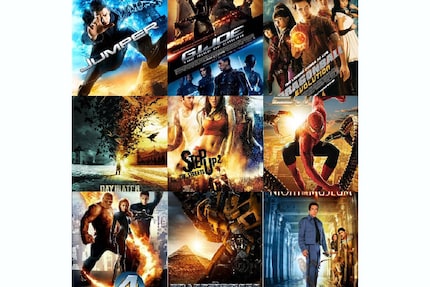
This results in a modern blockbuster look, which you’ve seen so often that you can tell whether a film was made before or after the turn of the millennium just from the colour grading. The problem is that the color grading we’ve got so used to in films has nothing to do with reality.
What does this mean for computer-generated effects? To answer this, let’s go back to the statement I made at the beginning of this article: the 1993 T-Rex is far more realistic than the one in «Jurassic World». This is mainly due to the aforementioned colour grading.
There was no such thing as colour grading when «Jurassic Park» was made. Instead, the filmmakers had to make things look like the real world – I know, it’s a crazy concept. Then as now, computer-generated effects should preferably not stand out. They’re made to fit in with the film’s aesthetic.
This is how the T-Rex looks in «Jurassic Park»:
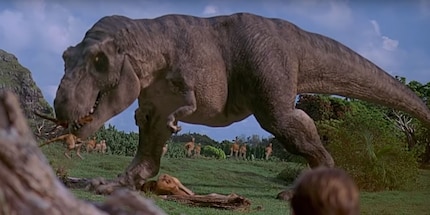
Obviously, the CGI is a bit outdated, but the T-Rex fits in with its surroundings so well – which also look natural – that the effects are passable even when measured against today’s standards.
«Jurassic World», on the other hand, is a victim of orange and blue colour correction, along with most modern blockbusters. How does it look when artificial computer-generated effects are added to an artificially-coloured image?
Unsurprisingly, the answer is: artificial.
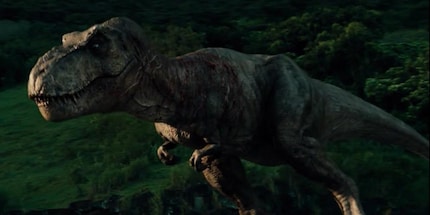
I tried an experiment. I wondered how the T-Rex in «Jurassic World» would look if I corrected the colours to mirror the natural look of the original.
First, a confession: I’m not a Photoshop expert and I know I haven’t done a perfect job, but I’m happy with it.
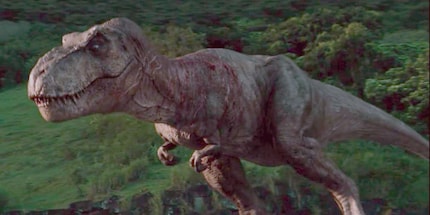
Maybe it’s because I adjusted it myself, but I think the T-Rex in the edited image looks much more natural and realistic than in the artificial original. It looks more lifelike and bulkier to me, in any case. It’s the exact same effect, I’ve only messed around with the colours a bit.
Are computer-generated effects getting increasingly worse? No, it’s the opposite. And even though this article might seem to be one long whinge, I think well thought-out effects are great, as long as they support – rather than replace – the story.
But do you see what colour grading can do? Ever-improving computer-generated effects have to be seamlessly added to films which are becoming ever more artificial and unrealistic – and the result backfires.
And that’s not all. Advanced computers provide filmmakers with ever more processing power to easily solve issues using CGI. This has resulted in films being overrun with artificial effects. But viewers find watching computer-animated protagonists in unrealistic battles about as exciting as a bout of diarrhoea. They switch off from events emotionally and lose any feeling of suspense.
Computer-generated effects that also reinvent reality and bypass the laws of physics are the icing on the artificial cake. It’s not that a film can’t contain any fantastical elements, but filmmakers have to think of new ways and means to create plausible peril for their protagonists. It’s the only way they can avoid losing their audience completely.
Or, to paraphrase Ian Malcolm from «Jurassic Park»: instead of being preoccupied with whether they can create dinosaurs with exploding helicopters all around, maybe they should stop to think if they should.
I write about technology as if it were cinema, and about films as if they were real life. Between bits and blockbusters, I’m after stories that move people, not just generate clicks. And yes – sometimes I listen to film scores louder than I probably should.
Interesting facts about products, behind-the-scenes looks at manufacturers and deep-dives on interesting people.
Show all